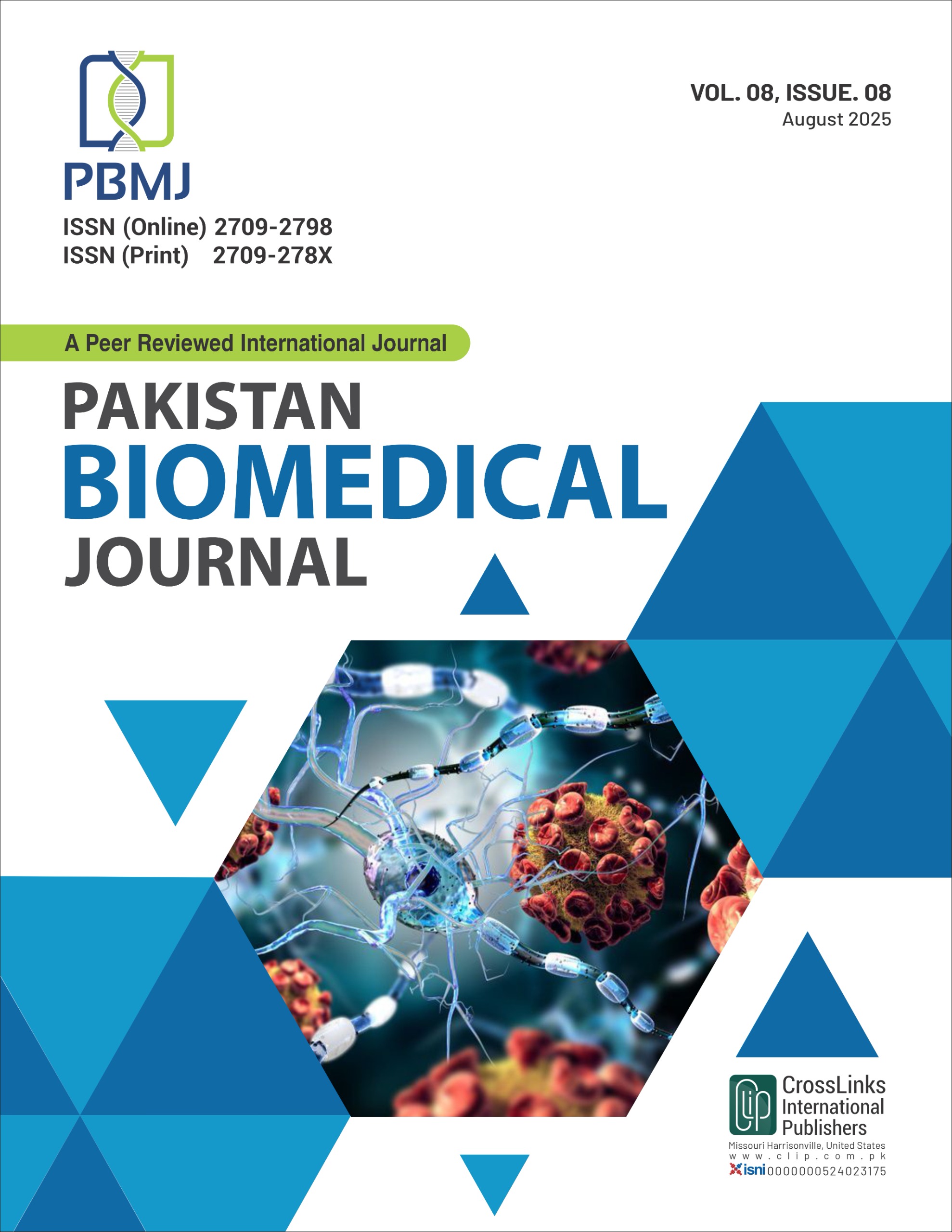Effectiveness of Passive Chest Physiotherapy with and without Mechanical Percussion among in Patients Children
Passive Chest Physiotherapy with and Without Mechanical Percussion
DOI:
https://doi.org/10.54393/pbmj.v8i8.1219Keywords:
Physical Therapy, Pneumonia, Percussion, Respiratory Tract InfectionsAbstract
The main cause of damage to lung tissue is pneumonia, a disorder marked by pulmonary inflammation or infection and brought on by a range of infectious agents. Objectives: To compare the benefits of mechanical percussions and chest physical therapy for pediatric hospital admission patients. Methods: A randomized controlled trial was conducted in the Pediatric Intensive Care Unit and the General Ward of Memon Medical Institute Hospital in Karachi, Pakistan. The study investigated 68 children who experienced lower respiratory tract infections and were hospitalized for an extended duration. The children ranged in age from one month to five years. The exclusion criteria encompassed patients with acute asthma, cystic fibrosis, pulmonary embolism, malignancies, rib fractures, spinal fusion, hemorrhage-prone diseases, recent neurosurgery that precluded head-down positioning, and pulmonary emboli. Participants were randomly allocated to either the experimental group or the control group. The experimental group underwent mechanical percussions during chest physiotherapy, whereas the control group received standard chest physiotherapy. The final assessments included the Modified Respiratory Distress Assessment Instrument (mRDAI), the Face, Legs, Activity, Cry, CONSOL ability (FLACC) scale, the Wang Clinical Severity Score (WCSS), oxygen saturation (SpO2), heart rate, and respiratory rate (RR). Evaluations were conducted both before and after the chest physical therapy session. Results: Improved FLACC ratings, a lower heart rate (p<0.05), and better scores on the mRDAI all point to notable changes in the experimental group following the intervention. Conclusions: Mechanical percussions in chest physical therapy clearly improved heart rate, the mRDAI, and the FLACC.
References
Ningrum FS, Febriansari RD, Maisyaroh AM, Musviro. Chest Physioterapy in Children with Pneumonia: A Literature Review. 2020.
Mehrem E, El-Mazary AA, Mabrouk MI, Mahmoud R. Study of Chest Physical Therapy Effect on Full Term Neonates with Primary Pneumonia: A Clinical Trial Study. International Journal of Pediatrics. 2018 Jul; 6(7): 7893-9.
Chaves GS, Freitas DA, Santino TA, Nogueira PA, Fregonezi GA, Mendonca KM. Chest Physiotherapy for Pneumonia in Children. Cochrane Database of Systematic Reviews. 2019; 2019(1). doi: 10.1002/14651858.CD010277.pub3.
Luthfianto MN and Irdawati I. The Effect of Chest Physiotherapy on Oxygen Saturation and Respiratory Rate in Pediatric Pneumonia. Jurnal Keperawatan. 2023 Dec; 15(4): 325-34. doi: 10.32583/keperawatan.v15i4.2000.
Kubo T, Osuka A, Kabata D, Kimura M, Tabira K, Ogura H. Chest Physical Therapy Reduces Pneumonia Following Inhalation Injury. Burns. 2021 Feb; 47(1): 198-205. doi: 10.1016/j.burns.2020.06.034.
Kim EK, Youn YS, Rhim JW, Shin MS, Kang JH, Lee KY. Epidemiological Comparison of Three Mycoplasma Pneumoniae Pneumonia Epidemics in A Single Hospital Over 10 Years. Korean Journal of Pediatrics. 2015 May; 58(5): 172. doi: 10.3345/kjp.2015.58.5.172.
Zhang T, Zhang J, Shao X, Feng S, Xu X, Zheng B et al. Effectiveness of 13-Valent Pneumococcal Conjugate Vaccine Against Community Acquired Pneumonia Among Children in China, an Observational Cohort Study. Vaccine. 2021 Jul; 39(33): 4620-7. doi: 10.1016/j.vaccine.2021.06.075.
Beletew B, Bimerew M, Mengesha A, Wudu M, Azmeraw M. Prevalence of Pneumonia and Its Associated Factors among Under-Five Children in East Africa: A Systematic Review and Meta-Analysis. BioMed Central pediatrics. 2020 May; 20(1): 254. doi: 10.1186/s12887-020-02083-z.
Sereearuno T, Rittayamai N, Lawansil S, Thirapatarapong W. Effectiveness of a Chest Physiotherapy Care Map in Hospitalized Patients. Heart and Lung. 2020 Sep; 49(5): 616-21. doi: 10.1016/j.hrtlng.2020.03.014.
Huang D, Zhao W, Chen Y, Shen B, Wang Y, Guan H et al. Effect of Mechanical Ventilation and Pulmonary Rehabilitation in Patients with ICU-Acquired Weakness: A Systematic Review and Meta-Analysis. Annals of Palliative Medicine. 2021 Sep; 10(9): 9594606-9606. doi: 10.21037/apm-21-1928.
Hue YL, Lum LC, Ahmad SH, Tan SS, Wong SY, Nathan AM et al. Safety, Tolerability and Efficacy of LEGA-Kid® Mechanical Percussion Device Versus Conventional Chest Physiotherapy in Children: A Randomized, Single-Blind Controlled Study. Singapore Medical Journal. 2022 Feb; 63(2): 105. doi: 10.11622/smedj.2020084.
Leowski J. Mortality from Acute Respiratory Infections in Children Under 5 Years of Age: Global Estimates. PAHO. Epidemiological Bulletin. 1986: 6-12.
Baron J and El-Chaar G. Hypertonic Saline for the Treatment of Bronchiolitis in Infants and Young Children: A Critical Review of the Literature. The Journal of Pediatric Pharmacology and Therapeutics. 2016 Jan; 21(1): 7-26. doi: 10.5863/1551-6776-21.1.7.
Kusuma E, Nastiti AD, Puspitasari RH. The Effect of Chest Physiotherapy on the Effectiveness of the Airway Among Pneumonia Patients at the Children's Room of Bangil Regional General Hospital. UNEJ e-Proceeding. 2022 Jul: 141-6.
Mane and Memushaj L. The Effects of Respiratory Physiotherapy in Pneumological Patients. ANGLISTICUM. Journal of the Association-Institute for English Language and American Studies. 2018 Sep; 7(8): 83-90.
Lestari NE, Nurhaeni N, Chodidjah S. The Combination of Nebulization and Chest Physiotherapy Improved Respiratory Status in Children with Pneumonia. Enfermería Clínica. 2018 Feb; 28: 19-22. doi: 10.1016/S1130-8621(18)30029-9.
Hassan EA and Amer HW. Impact of Regular Chest Percussion on Outcome Measures for Infants with Pneumonia. Journal of Nursing Education and Practice. 2020; 10(4): 11-20. doi: 10.5430/jnep.v10n4p11.
Mohamed NR, Ahmed SM, Mohammed MH, Sayed YM. Effect of Chest Percussion Post Nebulizer on Respiratory Status among Infants with Pneumonia. Minia Scientific Nursing Journal. 2023 Dec; 14(1): 13-22. doi: 10.21608/msnj.2023.232092.1076.
Pinto FR, Alexandrino AS, Correia-Costa L, Azevedo I. Ambulatory Chest Physiotherapy in Mild-to-Moderate Acute Bronchiolitis in Children Under Two Years of Age—A Randomized Control Trial. Hong Kong Physiotherapy Journal. 2021 Dec; 41(02): 99-108. doi: 10.1142/S1013702521500098.
Gomes GR and Donadio MV. Effects of the Use of Respiratory Physiotherapy in Children Admitted with Acute Viral Bronchiolitis. Archives De Pédiatrie. 2018 Aug; 25(6): 394-8. doi: 10.1016/j.arcped.2018.06.004.
Downloads
Published
How to Cite
Issue
Section
License
Copyright (c) 2025 Pakistan BioMedical Journal

This work is licensed under a Creative Commons Attribution 4.0 International License.
This is an open-access journal and all the published articles / items are distributed under the terms of the Creative Commons Attribution License, which permits unrestricted use, distribution, and reproduction in any medium, provided the original author and source are credited. For comments editor@pakistanbmj.com











